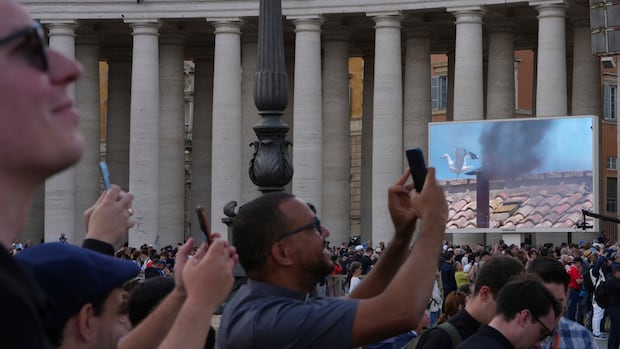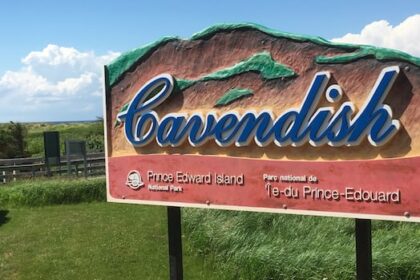May 86 minutes ago4th and 5th ballotsVerity StevensonPeople sit with umbrellas, shielding themselves from the sun, in St. Peter’s Square on the second day of the conclave. (Amanda Perobelli/Reuters)After two votes this morning yielded no new pope, the cardinal electors undertook their fourth ballot at around 4 p.m. local time (10 a.m. ET). Smoke could emerge from the Sistine Chapel chimney, this time, if the 133 cardinals have come to a decision. The thousands in St. Peter’s Square are watching in suspense that white smoke could come from that pipe.My colleague Margaret Evans, who is on the ground in the square, says that excitement has “been building all day long.” There were ups and downs throughout the day today, with the second plume of black smoke followed by a long lunch break for the cardinals. It’s a hot and sunny day, with many searching for shade and napping as they wait. “A lot of really high expectations here, not just for the faithful … but also tourists in a beautiful city and those who want to witness history,” Margaret said. 10 minutes agoFront-runners and dark horsesMegan WilliamsAfter inconclusive votes on Wednesday evening and this morning, the 133 cardinals face one or two more rounds of voting this afternoon. The front-runners are Italian Cardinal and Vatican Secretary of State Pietro Parolin, and Filipino Cardinal Luis Antonio Tagle, as we’ve highlighted lower down.If neither can secure the 89 votes needed for a two-thirds majority, others could emerge as surprise contenders. Potential “dark horse” candidates being discussed include France’s Jean-Marc Aveline, Hungary’s Peter Erdo, American Robert Prevost, Italy’s Pierbattista Pizzaballa, and Filipino Pablo Virgilio David.34 minutes agoPink smoke: Women demand a say in the churchMegan WilliamsMembers of the Catholic women’s group, Women’s Ordination Worldwide, hold flares of pink smoke, calling for women’s equality in the Catholic Church and in protest of the male-only conclave. (Matteo Minnella/Reuters)As cardinals locked themselves inside the Sistine Chapel on the first day of the conclave, a different kind of signal rose from a square overlooking St. Peter’s: Pink smoke.For decades now, activists from WOW (Women’s Ordination Worldwide) have protested the exclusion of women from the priesthood, and most decision-making roles in the Catholic Church.I’ve covered their protests at synods, priest gatherings and conclaves over the years and many times have interviewed the group’s executive director, Kate McElwee.Last night after their protest, I bumped into Kate and the other WOW women at a trattoria near the Vatican. They told me that after yesterday’s protest, when they tried to get near St. Peter’s Square to watch the smoke, police detained six of them, calling them a “security threat.” Police have banned them from the square for the rest of the conclave, they said.”We’re seen as dangerous simply for calling out sexism in the church,” said McElwee.37 minutes agoAbuse survivors call for canon law reform from next popeVerity Stevenson’The wound has never closed’: Advocates call for next pope to act swiftly against sexual abuseGemme Hickey, board president of Ending Clergy Abuse, says the organization wants the next pope to build on the work Pope Francis did against sexual abuse within the Catholic Church. Hi, I’m Verity and I am back curating your live updates today. Not everyone in Rome is watching the conclave in awe. Some are waiting more so in anticipation. Gemma Hickey, board president of Ending Clergy Abuse, is a survivor of religious institutional abuse. Hickey is currently in Rome to urge the church to shift its policy on clerics accused of sexual abuse, including canon law reform and mandatory reporting.They have been working with the Pontifical Gregorian University in Rome to help revise those laws.The group was hoping to present their work in June, but with Pope Francis’s death, “now we’re looking ahead to the next pope and try to deliver our message ahead of the conclave, so that they know where we stand because we’re not going to be patient any longer,” they told CBC News Morning Live host Heather Hiscox from St. Peter’s Square. “Survivors deserve more than symbolic gestures,” said Hickey, who is from Newfoundland and Labrador. “The wound has never closed. I don’t know if it will, but what we need to see are reforms.”The group wants Canon law to be applied all over the world, in a similar fashion to the exception Francis made in 2022 for the United States to prosecute bishops for abuse that occurred in Boston and elsewhere in that country.43 minutes agoHow old are the voting cardinals?Natalie StechysonMost cardinals eligible to take part in the conclave — and to become pope — are older than 60. (Graeme Bruce/CBC)Pretty old, mostly.Electors must be under 80 years old, and many of them are quite close. The average age of this group of electors is 70, and 15 of the cardinals squeaked in at age 79.The oldest, Spanish Cardinal Carlos Osoro Sierra turns 80 in just eight days, on May 16 — almost too old to vote.The youngest is Cardinal Mykola Bychok, an Australian, representing the elder millennials at age 45. There are 135 cardinals eligible to vote in Conclave, but two were unable to travel to Rome. So, 133 are currently participating.Just 15 of them are under age 60, and Bychok is the only one in his 40s.So while this may be the most geographically diverse group yet, with voting cardinals hailing from 71 different countries, they’re mostly around the same age — with a few outliers.That’s not surprising, given the time it takes to rise in the ranks of the Catholic Church; the typical path moves from priest, to bishop, to archbishop, to cardinal (with exceptions).1 hour agoDay 2 in the Sistine Chapel: A personal takeMegan WilliamsVatican City and the surrounding Rome are abuzz this week as thousands convene at St. Peter’s Square, awaiting as 133 cardinals vote to elect a new pope. (Megan Williams/CBC)As the cardinals cast their ballots under Michelangelo’s magnificent ceiling on Day 2 of the conclave, I’ve been thinking about a CBC Ideas radio documentary I did a few years ago about the Sistine Chapel — not just its art and history, but the deeply personal way one Canadian woman sees it.Jeannie Marshall, a Toronto writer who’s lived in Rome for years, avoided the chapel for a long time — too crowded, too overexposed. But after her Catholic mother died, something shifted. She started going back, again and again. At first she couldn’t explain why. Then she realized the chapel’s stories — of judgment, shame, beauty, survival — mirrored something in her own life.The ceiling fresco that hooked her was The Deluge, not as a story of salvation, but of people who didn’t make it onto the ark during the Great Flood. It spoke to her about climate change, grief, and Michelangelo’s quiet compassion.Marshall is not an art historian, which is what makes her book, All Things Move, so compelling. She shows how even the most iconic art can crack something open in us if we’re willing to really look.1 hour agoFrom shadow power to papal throne: Could Parolin be next?Megan WilliamsCardinal Pietro Parolin attends a mass on the fifth of nine days of mourning for late Pope Francis. (Alessandra Tarantino/The Associated Press)If elected pope, high-ranking contender Cardinal Pietro Parolin, the Vatican’s secretary of state, would be following in the footsteps of a rare but powerful tradition. Only five secretaries of state have become pope — all of them Italians, and all at turning points in Catholic Church history, when diplomatic reach was especially prized.Giulio della Rovere (Pope Julius II, 1503-1513), known for his military campaigns and commissioning of Michelangelo’s Sistine Chapel ceiling.Alessandro Farnese (Pope Paul III, 1534-1549), who convened the Council of Trent and kick-started the Counter-Reformation (in response to the Protestant Reformation).Fabio Chigi (Pope Alexander VII, 1655-1667), a scholar who clashed with France’s King Louis XIV and beautified Baroque Rome.Giulio Rospigliosi (Pope Clement IX, 1667-1669), a patron of the arts and skilled diplomat who sought peace in Europe.Eugenio Pacelli (Pope Pius XII, 1939-1958), who led the church during the Second World War and has been criticized for not doing enough to save Jewish people at that time.Like them, Parolin is a seasoned Vatican insider — Italian, influential, and well versed in the very Italian tradition of nuanced negotiation. His position also gives him a leg-up in a conclave because he’s one name all the cardinals know.2 hours agoOnly 2 popes have been elected in MayMegan WilliamsClergy members eat gelato in Rome on the second day of the conclave to elect a new pope. (Eloisa Lopez/Reuters)In over 2,000 years of papal elections, only two popes have been chosen in May — the month dedicated to the Madonna in the Roman Catholic calendar.The first came in 1342, during the Avignonese captivity, when the papacy was based in France due to conflict between the pope and the Roman nobles. That conclave opened on May 5 and after just two days, Cardinal Pierre Roger was elected Pope Clement VI. He led the Church through the early years of the Black Death. He’s known for his charitable efforts and protection of Jews from persecution during the plague.The second May election came in 1605, after Pope Leo XI’s brief 27-day papacy. That conclave began on May 8 and stretched to 27 rounds before the cardinals elected Camillo Borghese, who became Pope Paul V. (Villa Borghese Park and Gallery, among the largest parks in Rome, belonged to the family, along with many other properties in and around the city.) His papacy marked the beginning of a new Baroque era in Rome, with a major revitalization of the city — and papal power.2 hours agoThe pyrotechnics behind the black and white smokeNatalie StechysonA temporary stove inside the Sistine Chapel at the Vatican releases smoke signals — black or white — from the conclave. (Vatican Media via The Associated Press)As people around the world keep their eyes on the chimney on the Sistine Chapel, watching for either white or black smoke — the signal that the voting cardinals have either elected a new pope, or are still undecided — here’s a little background on the centuries-old tradition.After each round of voting, the ballots are burned in a special furnace.To make black smoke (no pope chosen), the ballots are mixed with potassium perchlorate, anthracene (a component of coal tar) and sulfur.To make white smoke (a new pope chosen), the ballots are mixed with potassium chlorate, lactose and chloroform.As Reuters explains, it’s all controlled electronically. The cardinals will have an electronic unit available to them that controls both the black and white pyrotechnic cartridges. A cardinal simply presses an “on” button, and the effect will be either black or white, and last about seven minutes.But behind the scenes, a master of ceremonies has been trained in how to use the furnace, Vatican City State explains. And in the days leading up to conclave, they conduct “smoke tests” to make sure everything is working as it should … “with discretion.”To be safe, one of the Vatican’s expert technicians gets locked in the conclave with the cardinals for the entire duration of the voting, staying in a small technical room near the Sistine Chapel. The technician has a remote control for the stove, and is ready to intervene “promptly” if needed.”So that no unforeseen event can hinder the famous and long-awaited white smoke,” Vatican City explains.3 hours ago’All we can do now is hope’ for a short conclaveMegan WilliamsNuns from Vietnam eat their lunch in the shade around St. Peter’s Square. (Emilio Morenatti/The Associated Press)Since Wednesday afternoon, when the conclave officially began and Vatican security sealed the Porta del Perugino — one of the key gates into Vatican City — life in Rome near the Santa Marta guesthouse, where the cardinal electors are staying, has gone oddly quiet, at least digitally. As part of the lockdown to ensure total conclave secrecy, all mobile and data networks inside the Vatican have been shut down. But the blackout doesn’t stop at the walls. Residents, businesses and restaurants just outside the walls are complaining cell service is down and payment systems don’t work.“All we can do now is hope it’s the shortest conclave in history,” one person said.
Black smoke billows from Sistine Chapel chimney for a 2nd time, indicating no new pope yet











